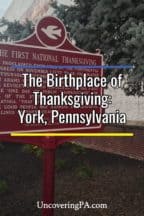The story of the first Thanksgiving is well known, but did you know that Pennsylvania was home to the first Thanksgiving in the United States once we became a country?
The Continental Congress fled to York just before Philadelphia was captured by the British Army in September 1777. From September 30, 1777 until June 27, 1778, Congress met out of York courthouse in the town square.
In addition to drafting the Articles of Confederation, our first system of government, one of the most memorable moments of their time in York came on November 1, 1777.
On October 31, 1777, official word reached York of the victory of General Horatio Gates and the Continental Army at the Battle of Saratoga in New York.
While the battle was a major victory for the United States, it was also a hard time having lost several recent battles, including the Battle of Brandywine, and the capital city of Philadelphia.

Because of this victory, Samuel Adams and Richard Henry Lee led the charge for a national day of thanksgiving. The next day, the Continental Congress declared December 18, 1777, as the first official Thanksgiving in the United States.
According to the proclamation written by Adams, the day was to be one “that with one heart and one voice the good people may express the grateful feelings of their hearts.”
For those that are curious, here is the full text of the proclamation declared by the Continental Congress in November 1777.
“Forasmuch as it is the indispensable duty of all men to adore the superintending providence of Almighty God; to acknowledge with gratitude their obligation to him for benefits received, and to implore such farther blessings as they stand in need of; and it having pleased him in his abundant mercy not only to continue to us the innumerable bounties of his common providence, but also smile upon us in the prosecution of a just and necessary war, for the defense and establishment of our unalienable rights and liberties; particularly in that he hath been pleased in so great a measure to prosper the means used for the support of our troops and to crown our arms with most signal success:
It is therefore recommended to the legislative or executive powers of these United States, to set apart Thursday, the 18th day of December next, for solemn thanksgiving and praise; that with one heart and one voice the good people may express the grateful feelings of their hearts, and consecrate themselves to the service of their divine benefactor;
and that together with their sincere acknowledgments and offerings, they may join the penitent confession of their manifold sins, whereby they had forfeited every favor, and their humble and earnest supplication that it may please God, through the merits of Jesus Christ, mercifully to forgive and blot them out of remembrance;
that it may please him graciously to afford his blessings on the governments of these states respectively, and prosper the public council of the whole; to inspire our commanders both by land and sea, and all under them, with that wisdom and fortitude which may render them fit instruments, under the providence of Almighty God, to secure for these United States the greatest of all blessings, independence and peace; that it may please him to prosper the trade and manufactures of the people and the labor of the husbandman, that our land may yield its increase;
to take schools and seminaries of education, so necessary for cultivating the principles of true liberty, virtue and piety, under his nurturing hand, and to prosper the means of religion for the promotion and enlargement of that kingdom which consisteth in righteousness, peace and joy in the Holy Ghost.
And it is further recommended, that servile labor, and such recreation as, though at other times innocent, may be unbecoming the purpose of this appointment, be omitted on so solemn an occasion.”
On December 18, the Continental Congress canceled their morning sessions so that delegates would have time to give thanks. George Washington also had his army observe the day in Gulph Mills, Pennsylvania.
The next day, they would march into Valley Forge and begin their winter encampment in the area.

It would be another 86 years before Thanksgiving would be recognized as a national holiday. This occurred in October 1863 when President Abraham Lincoln designated the last Thursday in November as a national day of thanksgiving during the Civil War.
The first Thanksgiving was a very solemn affair and celebrated with religious observances. This is in stark contrast to how we celebrate Thanksgiving today, but the holiday is still an important reminder for us to give thanks for the many great things in our lives.
And we can trace this great American holiday back to its foundations in 18th-century York, Pennsylvania.
Want to find out more? Tour the York Colonial Complex where the first Thanksgiving was declared. You can also see the above pictured historical marker along East Market Street between Duke and George Streets in downtown York.





 "
"




May have been declared there, but the 1st Thanksgiving was CELebrated on Dec. 11, 1777 at Guelph Mills, Montgomery Co., PA. Where 11,000 troops were encamped on their way to Valley Forge.